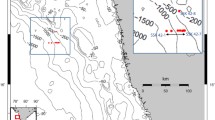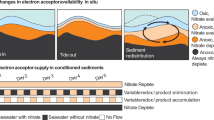Abstract.
The sulfur cycle of Ebro Delta microbial mats was studied in order to determine sulfide production and sulfide consumption. Vertical distribution of two major functional groups involved in the sulfur cycle, anoxygenic phototrophic bacteria and dissimilatory sulfate-reducing bacteria (SRB), was also studied. The former reached up to 2.2×108 cfu cm–3 sediment in the purple layer, and the latter reached about 1.8×105 SRB cm–3 sediment in the black layer. From the changes in sulfide concentrations under light-dark cycles it can be inferred that the rate of H2S production was 6.2 µmol H2S cm–3 day–1 at 2.6 mm, and 7.6 µmol H2S cm–3 day–1 at 6 mm. Furthermore, sulfide consumption was also assessed, determining rates of 0.04, 0.13 and 0.005 mmol l–1 of sulfide oxidized at depths of 2.6, 3 and 6 mm, respectively.
Similar content being viewed by others
Author information
Authors and Affiliations
Additional information
Electronic Publication
Rights and permissions
About this article
Cite this article
Mir, J., Martínez-Alonso, M., Caumette, P. et al. Sulfide fluxes in a microbial mat from the Ebro Delta, Spain. Int Microbiol 5, 133–138 (2002). https://doi.org/10.1007/s10123-002-0076-x
Received:
Accepted:
Published:
Issue Date:
DOI: https://doi.org/10.1007/s10123-002-0076-x




